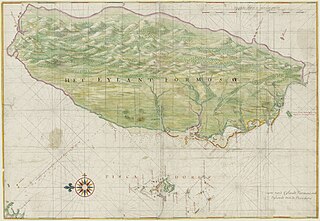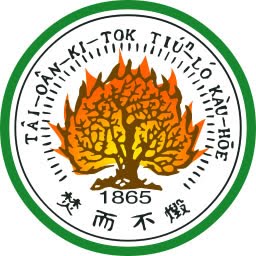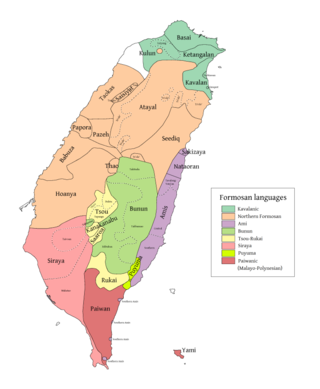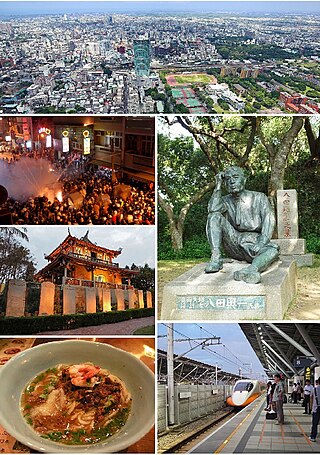
The history of the island of Taiwan dates back tens of thousands of years to the earliest known evidence of human habitation. The sudden appearance of a culture based on agriculture around 3000 BC is believed to reflect the arrival of the ancestors of today's Taiwanese indigenous peoples. Han Chinese gradually came into contact with Taiwan starting in the late 13th century and started settling there by the early 17th century. Named Formosa by Portuguese explorers, the south of the island was colonized by the Dutch in the 17th century whilst the Spanish built a settlement in the north which lasted until 1642. These European settlements were followed by an influx of Hoklo and Hakka immigrants from Fujian and Guangdong.

Taiwanese indigenous peoples, also known as Formosans, Native Taiwanese or Austronesian Taiwanese and formerly as Taiwanese aborigines, Takasago people or Gaoshan people, are the indigenous peoples of Taiwan, with the nationally recognized subgroups numbering about 569,000 or 2.38% of the island's population. This total is increased to more than 800,000 if the indigenous peoples of the plains in Taiwan are included, pending future official recognition. When including those of mixed ancestry, such a number is possibly more than a million. Academic research suggests that their ancestors have been living on Taiwan for approximately 15,000 years. A wide body of evidence suggests that the Taiwanese indigenous peoples had maintained regular trade networks with numerous regional cultures of Southeast Asia before the Han Chinese colonists began settling on the island from the 17th century, at the behest of the Dutch colonial administration and later by successive governments towards the 20th century.

Headhunting is the practice of hunting a human and collecting the severed head after killing the victim, although sometimes more portable body parts are taken instead as trophies. Headhunting was practiced in historic times in parts of Europe, East Asia, Oceania, Southeast Asia, South Asia, Mesoamerica, South America, West Africa and Central Africa.

The music of Taiwan reflects the diverse culture of Taiwanese people. Taiwan has undergone several economic, social, and political changes through its cultural history, and Taiwanese music reflects those issues in its way. The music of the country has adopted a mixed style. As a country rich in Chinese folk culture and with many indigenous tribes with their own distinct artistic identity, various folk music styles are appreciated in Taiwan. In addition, people in Taiwan highly appreciate various style of Western classical music and pop music. Taiwan is a major Mandopop hub.

The Presbyterian Church in Taiwan is the largest Protestant Christian denomination based in Taiwan.

The Musha Incident (Chinese and Japanese: 霧社事件; pinyin: Wùshè Shìjiàn; Wade–Giles: Wu4-she4 Shih4-chien4; rōmaji: Musha Jiken; Pe̍h-ōe-jī: Bū-siā Sū-kiāⁿ), also known as the Wushe Rebellion and several other similar names, began in October 1930 and was the last major uprising against colonial Japanese forces in Japanese Taiwan. In response to long-term oppression by Japanese authorities, the Seediq indigenous group in the settlement of Musha (Wushe) attacked a Japanese village, killing over 130 Japanese. In response, the Japanese led a relentless counter-attack, killing over 600 Seediq in retaliation. The handling of the incident by the Japanese authorities was strongly criticised, leading to many changes in Aboriginal policy.

Yujing District is a rural district in eastern Tainan, Taiwan. It is famous for its cultivation of mangoes.

Yang Kui or Yō Ki, originally named Yang Kui (楊貴), was a Taiwanese writer and social activist born in Tainan, Taiwan. He used pen names such as Yang-kuei (楊逵), Yang Chien-wen (楊建文), Lai Chien-erh (賴健兒), Lin Ssu-wen (林泗文), and Ito Ryo.
The term "Taiwanese people" has various interpretations. It may generally be considered the people living on the island of Taiwan who share a common culture, ancestry and speak Mandarin, Hokkien, Hakka, or indigenous Taiwanese languages as a mother tongue. Taiwanese people may also refer to the indigenous peoples of the areas under the control of the Government of the Republic of China since 1945, including Kinmen and Matsu Islands that collectively form its streamlined Fujian Province. However, the inhabitants of Kinmen and the Matsu Islands themselves may not consider the "Taiwanese" label to be accurate as they are a part of Fujian and not Taiwan. They have a distinctive identity from that of the Taiwanese; viewing themselves as Kinmenese or Matsunese, respectively, or as simply Chinese.

Kavalan was formerly spoken in the Northeast coast area of Taiwan by the Kavalan people (噶瑪蘭). It is an East Formosan language of the Austronesian family.

The island of Taiwan, together with the Penghu Islands, became a dependency of Japan in 1895, when the Qing dynasty ceded Fujian-Taiwan Province in the Treaty of Shimonoseki after the Japanese victory in the First Sino-Japanese War. The short-lived Republic of Formosa resistance movement was suppressed by Japanese troops and quickly defeated in the Capitulation of Tainan, ending organized resistance to Japanese occupation and inaugurating five decades of Japanese rule over Taiwan. The entity, historically known in English as Formosa, had an administrative capital located in Taihoku (Taipei) led by the Governor-General of Taiwan.

Baron Sadayoshi Andō, also known as Teibi Andō, was a general in the Imperial Japanese Army and 6th Governor-General of Taiwan from 30 April 1915 to 6 June 1918.

Uchida Kakichi was the 9th Governor-General of Taiwan from 6 September 1923 to September 1924. Prior to assuming the office of Governor-General, Uchida also served as Chief of Home Affairs under Governors-General Sakuma Samata and Ando Sadami, the second highest position in the colonial government.

The National Protection War, also known as the Anti-Monarchy War, was a civil war that took place in China between 1915 and 1916. Only three years earlier, the last Chinese dynasty, the Qing dynasty, had been overthrown and the Republic of China was established in its place. The cause of the war was the proclamation by Yuan Shikai, the President of the Republic, of himself as the Hongxian Emperor of China.

The Qing dynasty ruled over the island of Taiwan from 1683 to 1895. The Qing dynasty sent an army led by general Shi Lang and defeated the Ming loyalist Kingdom of Tungning in 1683. Taiwan was then formally annexed in April 1684.

Tainan, officially Tainan City, is a special municipality in southern Taiwan facing the Taiwan Strait on its western coast. Tainan is the oldest city on the island and commonly called the "prefectural capital" for its over 260 years of history as the capital of Taiwan under the Dutch rule, the Kingdom of Tungning and later Qing dynasty rule until 1887. Tainan's complex history of comebacks, redefinitions and renewals inspired its popular nickname "the Phoenix City". Tainan is classified as a "Sufficiency"-level global city by the Globalization and World Cities Research Network.

The Beipu Incident, or the Beipu Uprising, in 1907 was the first instance of an armed local uprising against the Japanese rule of the island of Taiwan. In response to oppression of the local population by the Japanese authorities, a group of insurgents from the Hakka subgroup of Han Chinese and Saisiyat indigenous group in Hoppo, Shinchiku Chō, attacked Japanese officials and their families. In retaliation, Japanese military and police killed more than 100 Hakka people. The local uprising was the first of its kind in Taiwan under Japanese rule, and led to others over the following years.
Five-year plan for governing aborigines, or the Five Year Plan to Subdue the Savages, was a program aimed to use military force to suppress the aborigine populations in Taiwan during the early years of the Japanese rule. It was enacted by the fifth Taiwanese governor general, Sakuma Samata from 1910 to 1915.

The Taiwanese Resistance to the Japanese Invasion of 1895 was a conflict between the short-lived Republic of Formosa (Taiwan) and the Empire of Japan. The invasion came shortly after the Qing dynasty's cession of Taiwan to Japan in April 1895 at the end of the First Sino-Japanese War.

The military history of Taiwan spans at least 400 years and is the history of battles and armed actions that took place in Taiwan and its surrounding islands. The island was the base of Chinese pirates who came into conflict with the Ming dynasty during the 16th century. From 1624 to 1662, Taiwan was the base of Dutch and Spanish colonies. The era of European colonization ended when a Ming general named Koxinga retreated to Taiwan as a result of the Ming-Qing War and ousted the Dutch in 1661. The Dutch held out in northern Taiwan until 1668 when they left due to indigenous resistance. Koxinga's dynasty ruled southwestern Taiwan as the Kingdom of Tungning and attacked the Qing dynasty during the Revolt of the Three Feudatories (1673-1681).


















